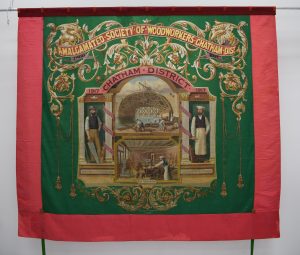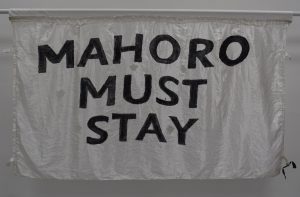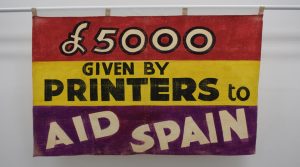We invited writer Emily Oldfield to review our 2020 Banner Exhibition. She is the Editor of Haunt Manchester seeking to celebrate alternative angles of the region.
Manchester is home to the national museum of democracy – the fascinating People’s History Museum – not only celebrating ‘ideas worth fighting for’, but holding the largest collection of political and trade union banners in the world. These impressive banners – many of which have been part of historic marches and rallies in the past – make up a quarter of the annually-changing gallery display; with the choice of banners for 2020 focusing on the theme of migration.
Migration – the movement of people from one place to another – has informed the human history of the world, an ongoing process and point for discussion, across societies. Here in Manchester for example, patterns of migration have included everything from the arrival of Roman campaigns, to the travelling of people for work, trade and refuge.
Migration affects and shapes us all, often in ways that we might not initially realise. The banners on display in the museum reflect this; although their links to migration might not be obvious at first, delving into the history behind them reveals fascinating connections. Banners are after all a piece of personal as well as political history – made by people, carried in marches, uniting groups under a cause they believe in and communicating key messages. From strike action throughout the centuries and personal campaigns, to protest marches including those against The Vietnam War, anti-immigration laws and the Poll Tax, banners have provided a point of unity, discussion and symbolism.
The exhibition includes a combination of those made by professional banner makers as well as homemade examples, all with stories behind them. These range from huge silk pieces adorned in artistry and beautiful sewing, to personally-sized banners – dating all the way from 1899 to examples made in 2019.
Across the 25 new banners on display for 2020, areas of discussion include; the legacy and issues of colonialism, communities supporting each other, the process of movement and the impact of legislation. The banners are interspersed over floors one and two of the museum gallery space, meaning that visitors can take them in amidst the museum’s wider collection.
Known for their thought-provoking and profound displays, People’s History Museum is also including nine banners that have never been on display before as part the 2020 Banner Exhibition – all maintained by the museum’s specialist team of conservators. This means that the public can come and learn fascinating stories about migration and protest they may not have heard before.

So what are some of the banners on display? The oldest is the huge pure silk example from the Amalgamated Society of Woodworkers in 1899 (seen here) – hand painted in oils and created in the London workshop of the notable banner maker George Tutill. The lavish materials of this banner link to a story of migration below the surface; as Tutill himself solidified his business in London so he could be close to the mainly migrant, highly-skilled silk weavers – many of Huguenot descent.
Some of the most recently-made banners on display meanwhile, include those from Revive Women’s Group (main image) – a local initiative supporting women refugees and those seeking asylum. As part of Refugee Week 2019, a number of women from the group worked with artist Ibukun Baldwin to create two striking banners; bold in their use of colour and the powerful messages conveyed. One banner declares ‘Treat us with respect and dignity’ whilst the other states ‘No torture and injustice but human rights’, highlighting the often harrowing experiences encountered by women in the migration process.
Revealing hidden and under-discussed aspects of history is a key feature of these banners. Take the Transport & General Workers’ Union (TGWU) banner for example – which although itself dates from the early 1980s, the union was first founded in 1922. It was the TGWU that helped lead the campaign to stop the exploitation of illegal immigrants, following the tragic drowning of Chinese cockle pickers working for gangmasters at Morecambe Bay in 2004; an incident that was recently discussed by Carey Davies in a ‘Country Diary’ entry in The Guardian. The TGWU proved a significant influence in its campaign to regulate practices of gangmasters and address their exploitation of migration labour – with the Gangmasters (Licensing) Act passed in 2004 and Gangmasters and Labour Abuse Authority established by 2005.
 A poignant handmade banner, created by campaigners themselves, is the ‘Mahoro Must Stay’ banner (pictured), dating from 2007. The slogan references the case of Mahoro Mugabo, a woman who arrived in the UK in 2002 seeking asylum from Rwanda, following the murder of her husband by militia forces and then being imprisoned and raped by her captors. As she was HIV positive, Mohoro was unable to access life-saving drugs in Rwanda, so sought asylum in the UK – coming to settle in Didsbury. Yet it was twice whilst living in Didsbury that Mahoro was taken away from her home by the authorities to a deportation centre – highlighting the UK as one of the few European countries to have no legal limit on the duration of detention.
A poignant handmade banner, created by campaigners themselves, is the ‘Mahoro Must Stay’ banner (pictured), dating from 2007. The slogan references the case of Mahoro Mugabo, a woman who arrived in the UK in 2002 seeking asylum from Rwanda, following the murder of her husband by militia forces and then being imprisoned and raped by her captors. As she was HIV positive, Mohoro was unable to access life-saving drugs in Rwanda, so sought asylum in the UK – coming to settle in Didsbury. Yet it was twice whilst living in Didsbury that Mahoro was taken away from her home by the authorities to a deportation centre – highlighting the UK as one of the few European countries to have no legal limit on the duration of detention.
The 2020 Banner Exhibition therefore shows the issues and tensions that can arise around migration – but also considers opportunities for unity too. In 2010, Mahoro was told she had the right to remain in the UK and throughout the process, she was significantly supported by a range of local councillors, the MP John Leech, her church in Fallowfield and many friends. In total, it had taken 8 years for Mahoro to gain the reassurance of right to remain, and yet she had continued to show compassion and kindness; known for her work as a volunteer counsellor supporting fellow HIV sufferers.
 Therefore, although the stories behind a number of these banners are difficult, they also highlight a diversity of people coming together to support each other – including the UK showing solidarity at times of international crises. Take the example of the Printers Aid Spain banner, dating from the late 1930s and showing support for the workers of Spain at the time of the Spanish Civil War. After the bombing of the Basque town of Guernica (April 1937) 4000 children were evacuated to Britain – an example of migration not often discussed and the information at the side of the banner highlights some of their experiences, as well as the difficulties faced. Powerful and informative, the People’s History Museum banner exhibition does not shy away from exposing the difficult truths and unhelpful prejudices about migration, allowing audiences to learn from the past and progress forwards.
Therefore, although the stories behind a number of these banners are difficult, they also highlight a diversity of people coming together to support each other – including the UK showing solidarity at times of international crises. Take the example of the Printers Aid Spain banner, dating from the late 1930s and showing support for the workers of Spain at the time of the Spanish Civil War. After the bombing of the Basque town of Guernica (April 1937) 4000 children were evacuated to Britain – an example of migration not often discussed and the information at the side of the banner highlights some of their experiences, as well as the difficulties faced. Powerful and informative, the People’s History Museum banner exhibition does not shy away from exposing the difficult truths and unhelpful prejudices about migration, allowing audiences to learn from the past and progress forwards.
Another banner – colourfully decorated and personally-sized, declaring Bread, Work and Freedom for the People of Chile was part of the demonstrations that took place in London to demand human rights for the people of Chile following the Chilean coup of 1973. A inspiring story of action that took place in response, was in the form of the UK based World University Service (WUS) that assisted over 900 Chileans fleeing General Pinochet’s persecution, to come to the UK.
The 2020 Banner Exhibition is therefore filled with stories of migration both insightful as well as inspiring, with impact all over the world. To be able to take in such artefacts, right here in Manchester, is a profound experience – so why not pay a visit?
Come along and browse two floors of galleries – with the banners interspersed throughout – as well as a unique viewing window into the specialist Conservation Studio; where each banner has been expertly cared for prior to hanging. See history in action, explore hidden heritage and be inspired.
Emily Oldfield is a writer currently based in Manchester, with a particular passion for hidden histories and accounts of place. She is the Editor of Haunt Manchester – running out of Manchester Metropolitan University and a subsection of Visit Manchester – seeking to celebrate alternative angles of the region.
Guest blogs are not curated by PHM but feature voices on topics relevant to the museum’s collection. Guest blogs do not necessarily reflect the views of PHM.
People’s History Museum is open seven days a week, from 10.00am to 5.00pm, Radical Lates are on the second Thursday each month, open until 8.00pm. The museum and its exhibitions are free to visit with a suggested donation of £5. To find out about visiting the museum, its full exhibition and events programme visit phm.org.uk.
Find out more about the 2020 Banner Exhibition, open until to Sunday 3 January 2021 here.